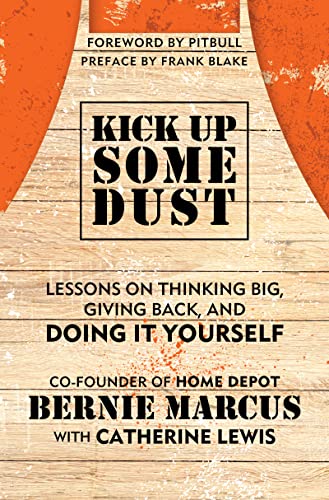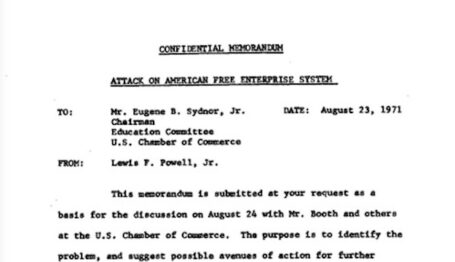Book Profile
Kick Up Some Dust by Bernie Marcus
 Credit: Jonathan Weiss. License: Shutterstock.
Credit: Jonathan Weiss. License: Shutterstock.

Editor’s Note: The CRC staff was deeply saddened to hear that Martin Morse Wooster was killed in a hit-and-run accident in Williamsburg, Virginia, on November 12, 2022.
One of the best ways donors can preserve their intentions is to make their intentions as explicit as possible. The more a donor says about his ideas and passions, the harder it is for his successors to violate donor intent.
In his memoir Kick Up Some Dust (co-written with Kennesaw State historian Catherine Lewis), Bernie Marcus, the co-founder of Home Depot, makes his intentions as a donor very clear. His memoir, which is half about his business career and half about his philanthropy, candidly recalls both his successes and failures as a philanthropist.

Bernie Marcus with Catherine Lewis, Kick Up Some Dust: Lessons on Thinking Big, Giving Back, and Doing It Yourself (New York: HarperCollins), 272 pp.
Early Years
Marcus was born in 1929. His parents were Jews who fled Russian tyranny for freedom and opportunity in America. In 1911, when she was 15, his mother Sara survived the Triangle Shirtwaist Fire, which killed 145 seamstresses at the Triangle Shirtwaist Factory in one of America’s worst industrial accidents.
Marcus grew up on the fourth floor of a tenement in Newark, New Jersey. His family struggled to survive the Great Depression with his father’s intermittent income as a cabinetmaker.
But even though the Marcus family in the 1930s had little money, Marcus’s family strongly believed in charity. Every week they would put some money in a metal box called a pushke. Every so often Sara Marcus would open the pushke and use the money she had accumulated to help a needy neighbor or to plant trees in Israel.
As a teenager, Bernie Marcus was annoyed at his mother using money he could have spent on snacks for charity. But after a while, Marcus stopped being mad at his mother and realized why charity mattered.
“Soon I was asking, “Who are we giving the (charity) money to this week?’ Instead of pouting, I had become a participant. She showed me how much charity mattered, and in the process, taught me something that has shaped my entire life.”
Marcus was graduated from Rutgers and earned an advanced degree from the Rutgers College of Pharmacy. He also served in the New Jersey Air National Guard.
Handy Dan
After graduating from pharmacy school, he worked as a pharmacist in one pharmacy and then was offered a 50 percent share of another one. Marcus liked managing stores more than working in them and ended up working for several retailers, eventually ending up in 1972 at Daylin, a company that ran 50 different chains. In 1972 he emerged in charge of one of them, Handy Dan Home Improvement Centers.
In seven years, Marcus made Handy Dan a highly profitable enterprise. But Daylin came under control of a corporate raider named Sandy Sigoloff, known as “Mr. Chapter 11’ for drastically shrinking companies to pay off creditors through a strategy known as “slash and burn.” While the other divisions of Daylin were drowning in red ink, Handy Dan remained profitable. Despite his success, Marcus was fired by Handy Dan in April 1978.
“This was, hands down, he lowest point of my life,,” Marcus writes. “I had never been fired before.” Marcus was 49, unemployed, and needing to support his wife and children.
Home Depot
His first thought was to sue Sigoloff, but friends talked him out of litigation. Instead, he and Arthur Blank, who was also fired by Sigoloff along with investor Ken Langone, founded Home Depot.
Home Depot was based on a premise that having a giant home improvement center that would satisfy all of a customer’s hardware needs would be successful if the customer could get everything he wanted in one place, rather than go to a hardware store, a lumber yard, and an appliance store. The stores would also offer classes so that customers could make their own repairs rather than hire contractors.
“That was our value proposition,” Marcus writes, “give customer low prices and a big selection, helpful associates, a chance to learn a valuable new skill that would save them money and give them a sense of accomplishment.” The clerks were trained to be experts in home improvement, and every store had a licensed electrician and lumber.
“If you treat people well, they feel their work matters,” Marcus writes. “And if you make them feel like they own a piece of the company, even better. Respect breeds respect.”
Do-It-Yourself Culture
As part of the core value that Home Depot employees knew what they were doing, power was devolved from the home office in Atlanta to local stores, which were given a great deal of autonomy. This allowed these stores to perform charity without getting permission from headquarters.
In 1992, after Hurricane Andrew, some Florida stores closed while other stores set up tents for first responders. Marcus worked with the Florida governor’s office, who agreed to provide escorts for Home Depot trucks to prevent them from being hijacked. Marcus also went on television to say his company would cut off business with any supplier who raised prices as a result of the hurricane.
After the Alfred P. Murrah Federal Building in Oklahoma City was blown up in 1995, managers of Home Depot Oklahoma City stores loaded all their trucks with shovels, wheelbarrows, tarps, and plywood—anything they thought would be helpful. They didn’t call headquarters. They didn’t ask superiors for permission. They just made sure that generators were available and that the first responders had axes and search lights. Nobody asked them to come. They just showed up
“That is the heart of our do-it-yourself culture,” Marcus writes. “We gave our managers that kind of autonomy—it was up to them to find out what their community needed and when.
”
Home Depot practices corporate philanthropy through the Homer Fund, begun in 1999 when Marcus received a phone call from an associate who needed money to pay for his parent’s funeral. Marcus decided Home Depot needed an internal safety net to enable employees to pay for unexpected major expenses. He donated $5 million to what he called the Homer Fund and convinced Arthur Blank and Ken Langone to match his donation. The fund helps pay for major medical expenses and other unexpected bills. Although Marcus, Blank, and Langone continue to donate to the Homer Fund, Marcus is proud that 95 percent of Home Depot employees also make donations. The Homer Fund, he writes, “shows what entrepreneurial philanthropy can and should do.”
Philanthropist
Bernie Marcus founded the Marcus Foundation in 1989. In 1997 he stepped down as Home Depot CEO but remained chairman of the board until he retired in 2002 and became a full-time philanthropist.
Georgia Aquarium. The major gift he has made is the Georgia Aquarium. In 2000, Marcus was in Israel where he happened to run into Georgia Gov. Roy Barnes in the lobby of the King David Hotel in Jerusalem. Marcus offered to give Barnes a lift home on his corporate jet and during the 15-hour flight, Marcus said, “I want to do something for the people of Atlanta and Georgia but I don’t know what.”
“What do you like to do when you are not working?” Barnes asked. “What do you really enjoy?”
“I thought for a while and it hit me—big fish,” Marcus writes. “I loved going to aquariums. No matter where I traveled for Home Depot, I would often take a break for a couple of hours and go visit an aquarium. I especially liked octopi. Watching fish gave me a sense of peace.” In addition, Marcus thought that an aquarium was something every Home Depot employee could enjoy.
Marcus decided to commit $250 million of Marcus Foundation money to an aquarium. He wanted to pay for the cost of the new aquarium in full, so that the facility would operate debt-free rather than getting in debt to pay construction costs.
In 2001 Marcus, his wife Billi, Marcus Foundation executive director Rick Slagle, and aquarium project director Jeff Swanagan traveled 55,000 miles visiting aquariums in the U.S. and in Asia. He persuaded Coca-Cola to abandon plans for a downtown amusement park to donate 10 acres for the foundation and convinced UPS to provide in-kind contributions transporting fish from Asia to Atlanta on one of their cargo planes.
Finally, he called on Atlanta mayor Shirley Franklin to help deal with city bureaucracy. Franklin called her staff into her office and said, “Nobody is going to stand in our way” in building the aquarium. “If you drag your feet on anything related to this project, you’d better look for another job.”
At one point, the Atlanta fire department held up getting a certificate of occupancy for the building. Mayor Franklin showed up the next day with the fire chief and ordered somebody from the fire department to be at the construction site every day. “If there is a problem, I want you to fix it immediately,” she said.
Shirley “changed everything, and we owe her a good deal of gratitude.” Marcus writes.
The Georgia Aquarium opened in November 2005 and attracts millions of visitors each year.
Supporting Veterans. A second major Marcus Foundation program is supporting veterans. Marcus served in the Air National Guard, but he notes his brothers, uncles, and cousins all served in World War II, and all came home with mental health problems that in World War II was called “shell shock” and today is called post-traumatic stress disorder (PTSD).
“Veterans are underpaid, struggle to reintegrate into society after being discharged, and when wounded are treated like second-class citizens when seeking medical treatment,” Marcus writes. “They are treated as disposable.”
Marcus says when he and Arthur Blank were running Home Depot, both men “made sure that the company was friendly to veterans.” He routinely had “Breakfast with Bernie” video chats with company employees serving in Afghanistan and Iraq. Home Depot partners with the Defense, Labor, and Veterans Affairs department to help steer veterans toward jobs in the company. Both Home Depot and the Home Depot Foundation offer training for veterans. “This might explain why, today, there are more than 35,000 Home Depot associates that are veterans, military reservists, or spouses. “Home Depot pays the difference between their salaries and military pay when reservists are training or when veterans are deployed.
The Marcus Foundation has a major commitment to helping wounded veterans rehabilitate. The foundation has steadily funded the Shepherd Center, a veterans’ rehabilitation center in Atlanta. In the summer of 2007, Marcus read in the Spinal Column, the center’s publication, about Eric Jordan, who at 23 was severely injured by an improvised explosive device in Iraq. He had received some rehabilitation at the Walter Reed National Military Medical Center and the James A. Haley Veterans’ Hospital in Tampa, but he was discharged and told he would “have to live with his injuries.”
Eric Jordan’s mother, Carrie Jordan, wanted to have her son take part in the extensive rehabilitation at the Shepherd Center, but she couldn’t afford it. Insurance wouldn’t cover the center’s fees, and the Veterans Administration refused to pay. The Marcus Foundation, after reading the article, decided to help pay for Eric Jordan’s therapy, and Eric Jordan, after four weeks of physical therapy, relearned to walk.
In 2008, the Marcus Foundation launched the SHARE (Supporting Hope and Recovery Excellence) Military Initiative in 2008 with a $2 million grant, which enabled wounded veterans to come to Atlanta and receive intensive physical therapy. Once discharged, the initiative funds a case worker for two years to help the veterans fully recover.
But SHARE only helped veterans who could come to Atlanta. In 2013, the Marcus Foundation launched an effort to replicate the Shepherd Center’s programs nationally, and in 2017 launched the Marcus Institute for Brain Health at the Anschutz Campus of the University School of Medicine. (The campus was founded with major support from the Anschutz Foundation.) The Marcus Foundation also supports nonprofits that help veterans adjust to modern life, including the Gary Sinise Foundation, the Stephen Siller Tunnel to Towers Foundation, the Warrior Alliance, and Team Red, White, & Blue.
In 2019, the Marcus Foundation launched the Avalon Fund as a national effort to help veterans deal with post-traumatic stress disorder and traumatic brain injuries with a goal of raising $200 million. Blank, Marcus’s fellow Home Depot co-founder, through the Arthur M. Blank Family Foundation donated $5 million to SHARE and $15 million to the Avalon Network. Other donations have come from the Goldring, Manat, and Veterans United foundations, Lockheed Martin, USAA, and the Irsay family, owners of the Indianapolis Colts.
“We will not rest,” Marcus writes, “until every veteran who suffers the invisible wounds of war has that opportunity to turn that struggle into profound strength.”
Autism. Marcus is candid about his failures. He had a longstanding interest in dealing with autism, founding what is now called the Marcus Autism Center in 1991. But he believes that his autism funding is less successful than it could have been “because the condition was not well understood, it was almost impossible to attract financial support.” He now believes his autism grants have become more successful, and notes his support of Children’s’ Healthcare of Atlanta, who supports the research of Dr. Ami Klin, who developed “cutting-edge eye-tracking technology to diagnose autism in younger children.”
Advice to Grantees
Marcus also has advice for prospective grantees. His basic lesson: Don’t waste his time by pretending the “chat” you came to the Marcus Foundation for is anything less than a fundraising pitch.
If you have a meeting with Marcus Foundation staff, he writes, “Don’t lie about your visit. Don’t act like you are just ‘in the neighborhood.’ Be bold and explain what you need and why. Success depends on making your intentions clear. Otherwise, nobody will trust you.”
His case study of bad fundraising is Rutgers. Shortly after Marcus co-founded Home Depot, he received a call from the president of Rutgers inviting him to give a speech to the business school. “But it became really obvious that he wanted me to donate millions to name a building,” Marcus writes.
Marcus explains that the Rutgers president should have let him give the speech, invited Marcus to meet members of the Rutgers board, and then gradually build a connection that would lead to a donation over the long term. Instead, Marcus writes, the Rutgers president “pulled a bait-and switch,” and the deception made sure that the Marcus Foundation checkbook would remain firmly closed to Rutgers University.
“I had two degrees from Rutgers and would likely have become an enthusiastic donor,” Marcus writes. “I was the very definition of low-hanging fruit.”
“I have donated millions to colleges and universities all over the United States for the past 30 years—Johns Hopkins, Emory, Case Western Reserve, and Duke. Note that Rutgers is not on the list.”
By contrast, Marcus praises Ilan Regenbaum, who, at age 13, “called out of the blue” for a meeting. His mother drove her son to the meeting where he explains that after getting a bar or bat mitzvah at 13, Jewish day schools send their students to Israel. Regenbaum’s presentation was “well-researched, squarely fit our mission, focused on helping others, and was passionate.” The Marcus Foundation agreed after the meeting to donate $50,000 to every Jewish day school for scholarships and has continued to give money (including a recent $20 million donation to RootOne) to help Jewish American teenagers visit the state of Israel.
Donor Intent
Marcus says his foundation will sunset within 20 years of his death. He recommends my book How Great Philanthropists Failed and How You Can Succeed at Protecting Your Legacy about how “Henry Ford, J. Howard pew, Andrew Carnegie, and John D. MacArthur left few instructions or restrictions on how the funds should be spent” after their deaths.
Marcus says he personally witnessed the failure of donor intent “with other foundations that had been set up by friends or colleagues.”
Marcus says that two of his adult children are on the Marcus Foundation board and have their own foundation. But when Marcus dies, the Marcus Foundation will get 90 percent of his assets” and the foundation will have 20 years to spend down.
The Marcus Foundation term limit, Marcus writes, “will help ensure that my assets will go to causes that I personally support and that they will be spent wisely by people who know my intentions. If you don’t sunset, you’re crazy.”
“One of the best parts of giving is seeing how lives are changed,” Marcus concludes. “There is so much joy in helping somebody, and how am I going to do that from a coffin?”



